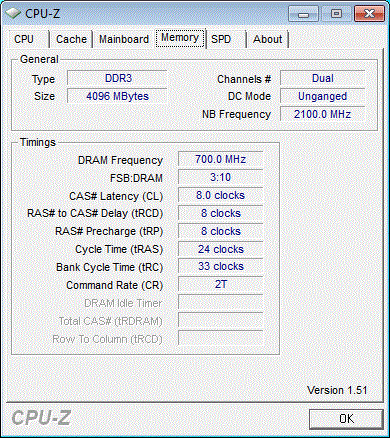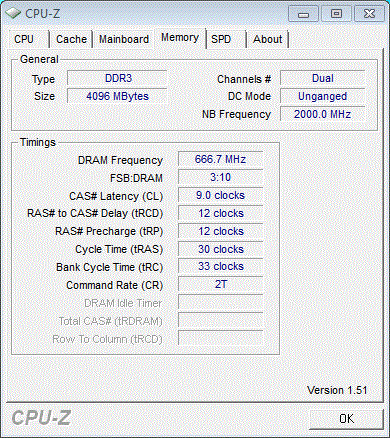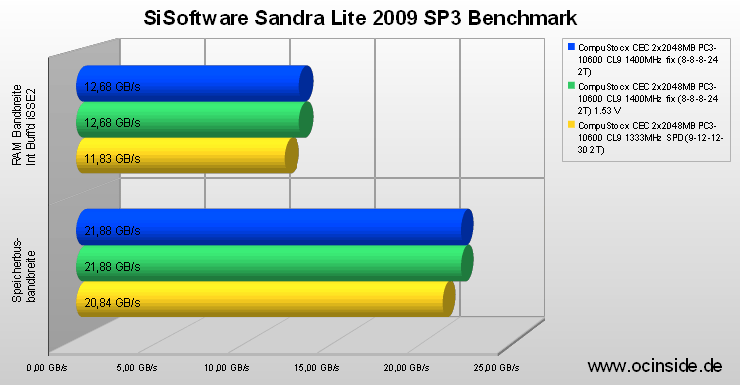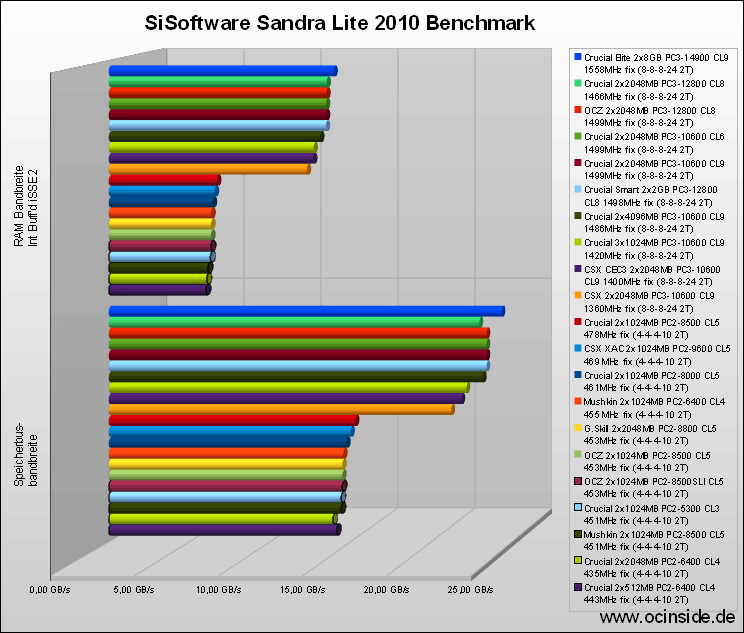
Let us continue with the most important part of the test report, the highest possible stable performance. The multiplier adjustment remains on 13x with all frequencies, because an adjustment for the CPU in half multiplier steps would be too inaccurate to get nearly the same CPU frequency for all tests. Microsoft Windows 7 RC Ultimate Edition is used as the operating system. The stability was examined with the software Memtest86
and SiSoft Sandra Lite 2009 SP3 program is used for all benchmarks, since it offers extensive adjustments and a fast result comparison. BTW. the latest SiSoft Sandra 2009 version is available on our download server and can be downloaded much faster. All benchmarks are also included in the free Sandra Lite version.
First the maximum possible frequency of the memory module was determined with default 1.50 Volt (1,53V). The memory frequency was increased in small steps with a fixed memory timing of 8-8-8-24 2T and default memory voltage, as long as the detailed memory test with Memtest86 runs without any errors. This quite long testing time ensured that this frequency works really stable with these modules.
The highest possible frequency with 8-8-8-24 2T (CAS-TRCD-TRP-TRAS) timings and 1.53V was only 700 / 1400 MHz, which is only a little bit higher than the default of 666/1333 MHz.
Here is a Snipping screenshot of CPU-Z with 700 / 1400 MHz and 8-8-8-24 2T with 1,53 Volt:

It was possible to run a bit higher frequencies with increased voltages or lower timings, because the frequency and timings depends directly from each other. But officially CSX specify only a voltage of 1.50 Volt without loosing the warranty. Of course we have tested the modules also with higher voltages, but the result was not much higher. Also with 2.00 Volt, this kit reached on CL8 just a bit more than 700 MHz (DDR3-1400).
The benchmark comparison of all DDR3 memory modules were tested with the default 1.53 V, where these CompuStocx 4GB modules reached 1400 MHz without any errors. This highest possible clocking on the default DDR3 voltage was compared now with two other settings. On the one hand they were tested with 200 MHz reference clock x6,66 = 1333 MHz and SPD values (SPD values are programmed in the SPD IC by the manufacturer). On the other hand the highest possible frequency with the permitted manufacturers voltage was determined at 8-8-8-24 2T. But in case of these CSXO-CEC3-DDR3 modules the highest voltage was identical with the lowest test voltage, so the second test is equal to the first result.
With a frequency of approx. 667 MHz the timings by SPD EEPROM autodetection were 9-12-12-30 2T (CAS-TRCD-TRP-TRAS).
Here is a Snipping screenshot of CPU-Z with 666.7 / 1333 MHz and 9-12-12-30 2T:

Here are the SiSoftware Sandra 2009 benchmark results:
| Frequency | Timing | Memory Voltage | RAM Range Int Buff’d iSSE2 | Memory Bus Range | Memory Latency |
| 210 MHz * 6,66 = 1400 MHz | fix (8-8-8-24 2T) | 1.53 Volt | 12,68 GB/s | 21,88 GB/s | 80 ns |
| 210 MHz * 6,66 = 1400 MHz | fix (8-8-8-24 2T) | 1.53 Volt | 12,68 GB/s | 21,88 GB/s | 80 ns |
| 200 MHz * 6,66 = 1333 MHz | SPD (9-12-12-30 2T) | 1.53 Volt | 11,83 GB/s | 20,84 GB/s | 92 ns |
The “Memory Bus Range” is no benchmark value, but this value is quite simple to calculate by the frequency and this value is useful for a benchmark comparison.
Here’s a diagram of the benchmark values:

Here is a direct benchmark result comparison of some DDR3, DDR2 and DDR memory modules:

The CompuStocx PC3-10600 kit could be overclocked with JEDEC standard voltage of 1.50 V only very slightly and was thereby only a little bit over the previously tested CSX Original PC3-10600 4GB memory kit without RAM cooler. Also a high memory voltage increasement only result in a few more megahertz and here should be the strengths of OC modules.

